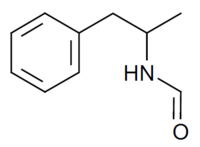Formetorex
Formetorex
 |
| Names |
| IUPAC name
N-(1-Phenylpropan-2-yl)formamide |
| Other names
Formetorex
N-Formylamphetamine
N-(alpha-Methylphenethyl)formamide |
| Identifiers |
| |
|
| ChemSpider |
|
| |
|
InChI=1S/C10H13NO/c1-9(11-8-12)7-10-5-3-2-4-6-10/h2-6,8-9H,7H2,1H3,(H,11,12)
|
| |
| Properties |
| |
C10H13NO |
| Molar mass |
163.22 g·mol−1 |
Except where otherwise noted, data are given for materials in their standard state (at 25 °C [77 °F], 100 kPa). |
|
| Infobox references |
|
|
Formetorex (INN), also known as formetamide or N-formylamphetamine, is an amphetamine described as an anorectic which does not appear to have ever been marketed.[1]
Formetorex is also an intermediate in the production of amphetamine by the "Leuckart reaction."[2] It is also commonly found as an impurity in clandestine labs where this synthesis method is used.[2][3] Due to the simplicity of the Leuckart reaction, it is the most popular synthetic route employed for the illicit manufacture of amphetamines.[2] The synthesis involves a non-metal reduction that is typically carried out in three steps.[2] For amphetamine synthesis, a mixture of phenylacetone and formamide (sometimes in the presence of formic acid) or ammonium formate, is heated until a condensation reaction results in the intermediate product, formetamide.[2] In the second step, formetamide is hydrolysed using hydrochloric acid, and the reaction mixture is then basified, isolated, and steam distilled to produce the free base.[2] The final step, the product is dissolved in an organic solvent and precipitated as the sulphate salt of amphetamine by adding sulfuric acid.[2]
References
External links
|
|---|
Main articles
and
pharmaceuticals | | |
|---|
| N/A |
|---|
|
- Dexedrine
- ProCentra
- Zenzedi
|
|---|
| |
|---|
|
|---|
| Neuropharmacology | |
|---|
| Active metabolites | |
|---|
| Related articles | |
|---|
|
|---|
| Adamantanes | |
|---|
| Adenosine antagonists | |
|---|
| Alkylamines | |
|---|
| Ampakines | |
|---|
| Arylcyclohexylamines | |
|---|
| Benzazepines | |
|---|
| Cholinergics | |
|---|
| Convulsants | |
|---|
| Eugeroics | |
|---|
| Oxazolines | |
|---|
| Phenethylamines |
- 1-(4-Methylphenyl)-2-aminobutane
- 1-Methylamino-1-(3,4-methylenedioxyphenyl)propane
- 2-Fuoroamphetamine
- 2-Fuoromethamphetamine
- 2-OH-PEA
- 2-Phenyl-3-aminobutane
- 2,3-MDA
- 3-Fuoroamphetamine
- 3-Fluoroethamphetamine
- 3-Fluoromethcathinone
- 3-Methoxyamphetamine
- 3-Methylamphetamine
- 3,4-DMMC
- 4-BMC
- 4-CMC
- 4-Ethylamphetamine
- 4-Fluoroamphetamine
- 4-Fluoromethamphetamine
- 4-MA
- 4-Methylbuphedrone
- 4-Methylcathinone
- 4-MMA
- 4-Methylpentedrone
- 4-MTA
- 6-FNE
- AL-1095
- Alfetamine
- a-Ethylphenethylamine
- Amfecloral
- Amfepentorex
- Amfepramone
- Amidephrine
- 2-Amino-1,2-dihydronaphthalene
- 2-Aminoindane
- 5-(2-Aminopropyl)indole
- 2-Aminotetralin
- Acridorex
- Amphetamine (Dextroamphetamine, Levoamphetamine)
- Amphetaminil
- Arbutamine
- β-Methylphenethylamine
- β-Phenylmethamphetamine
- Benfluorex
- Benzedrone
- Benzphetamine
- BDB
- BOH
- 3-Benzhydrylmorpholine
- BPAP
- Buphedrone
- Bupropion
- Butylone
- Camfetamine
- Cathine
- Cathinone
- Chlorphentermine
- Cilobamine
- Cinnamedrine
- Clenbuterol
- Clobenzorex
- Cloforex
- Clortermine
- Cypenamine
- D-Deprenyl
- Denopamine
- Dimethoxyamphetamine
- Dimethylamphetamine
- Dimethylcathinone
- Dobutamine
- DOPA (Dextrodopa, Levodopa)
- Dopamine
- Dopexamine
- Droxidopa
- EBDB
- Ephedrine
- Epinephrine
- Epinine
- Etafedrine
- Ethcathinone
- Ethylnorepinephrine
- Ethylone
- Etilamfetamine
- Etilefrine
- Famprofazone
- Fencamfamin
- Fencamine
- Fenethylline
- Fenfluramine (Dexfenfluramine, Levofenfluramine)
- Fenproporex
- Feprosidnine
- Flephedrone
- Fludorex
- Formetorex
- Furfenorex
- Gepefrine
- Hexapradol
- Hexedrone
- HMMA
- Hordenine
- 4-Hydroxyamphetamine
- 5-Iodo-2-aminoindane
- Ibopamine
- IMP
- Indanylamphetamine
- Iofetamine
- Isoetarine
- Isoethcathinone
- Isoprenaline
- L-Deprenyl (Selegiline)
- Lefetamine
- Lisdexamfetamine
- Lophophine
- MBDB
- MDA
- MDBU
- MDEA
- MDMA
- MDMPEA
- MDOH
- MDPR
- MDPEA
- Mefenorex
- Mephedrone
- Mephentermine
- Metanephrine
- Metaraminol
- Mesocarb
- Methamphetamine (Dextromethamphetamine, Levomethamphetamine)
- Methoxamine
- Methoxyphenamine
- MMA
- Methcathinone
- Methedrone
- Methoxyphenamine
- Methylenedioxycathinone
- Methylone
- Mexedrone
- MMDA
- MMDMA
- MMMA
- Morforex
- N,alpha-Diethylphenylethylamine
- N-Ethylbuphedrone
- N-Ethylhexedrone
- N,N-Dimethylphenethylamine
- Naphthylamphetamine
- Nisoxetine
- Norepinephrine
- Norfenefrine
- Norfenfluramine
- Normetanephrine
- L-Norpseudoephedrine
- Octopamine (drug)
- Orciprenaline
- Ortetamine
- Oxifentorex
- Oxilofrine
- PBA
- PCA
- PCMA
- PHA
- Pentorex
- Pentedrone
- Pentylone
- Phenatine
- Phenpromethamine
- Phentermine
- Phenylalanine
- Phenylephrine
- Phenylpropanolamine
- Pholedrine
- PIA
- PMA
- PMEA
- PMMA
- PPAP
- Phthalimidopropiophenone
- Prenylamine
- Propylamphetamine
- Pseudoephedrine
- Ropinirole
- Salbutamol (Levosalbutamol)
- Sibutramine
- Synephrine
- Theodrenaline
- Tiflorex
- Tranylcypromine
- Tyramine
- Tyrosine
- Xylopropamine
- Zylofuramine
|
|---|
| Phenylmorpholines | |
|---|
| Piperazines | |
|---|
| Piperidines | |
|---|
| Pyrrolidines | |
|---|
| Racetams | |
|---|
| Tropanes | |
|---|
| Tryptamines | |
|---|
| Others | |
|---|
|

